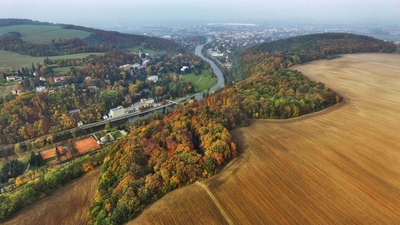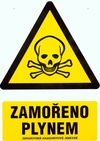Zbrašov Aragonite Caves - Natural conditions

GEOLOGICAL DEVELOPMENT OF THE AREA
The Hranice Karst is situated at the interface of two geological units – the Bohemian Massif and the Western Carpathians – and, due to its development; it is a site of world importance. Like most of the karst areas in Moravia, it is formed by a thick formation of limestones from the Middle to Late Devonian (350–380 million years), with their development even reaching back to the Early Carboniferous. During the Alpine-Carpathian folding the nearby Carpathian Mountains were created, which also affected this area – sediments of Cretaceous and Paleogene Carpathian flysch covered the limestone layers. By virtue of erosion and tectonic movements, the limestone massif became increasingly exposed. New caves were created and the karst relief started to be modified to its final shape, a conical karst with cone structures – mogotes, which are typical for tropical areas of Asia and the Caribbean today. During the Tertiary marine flooding Northern Moravia was overwhelmed by the sea and the area was covered by other non-karst sediments. Only the tops of the former mogotes then stayed visible. The major part of the karst area was buried and only exposed outcrops of limestones underwent intensive karstification. In the Zbrašov Aragonite Caves sediments with fossils of molluscs survived from the Tertiary marine flooding, which proves that karst cavities already existed there at that time. From the Tertiary period, hydrothermal springs also significantly influenced the dissolution and removal of the Hranice limestones. In consequence of tectonic unrest on deep faults between the Bohemian Massif and the Carpathian system, they emerge here from great depths and create underground cavities that run from the depths to the surface.

Mineral water at temperatures of up to 22.5 °C, probably originating from depths of about 700 m, is considerably aggressive due to its high content of carbon dioxide; it intensively dissolves limestones and is modelling the underground cavities in a characteristic way. That is why karstologists refer to the Hranice Karst as a conical hydrothermal cryptokarst.
STALACTITE, STALAGMITE AND MINERAL FILLINGS
Calcium carbonate (CaCO3), the raw material of calcite, crystallizes in three modifications:
Calcite is the most common. Crystallizes in a trigonal system and forms crystals called rhombohedrons and scalenohedrons.

Aragonite is a less common, high-temperature modification. It crystallizes in a rhombic system and generally forms needle-like crystals.
Vaterite is a rare modification which crystallizes in a hexagonal system.
The temperature and chemical conditions of the Zbrašov Aragonite Caves and their mineral waters are sufficient for the formation of aragonite. In addition to needle-like aggregates, it also forms solid coatings in the caves.

Geyser stalagmites are aphenomenon of the Zbrašov caves that is unique in the world. They have a characteristic conical shape and are up to several centimetres high. There is a hole in the top of the stalagmite and from the longitudinal cross-section it is apparent that the stalagmites “grew” in layers. Their central input channel cannot be proved with certainty, but their porous structure is quite distinct. There are two theories of their origin and growth. One of the theories supposes that they were formed by crystallization of calcium carbonate in places where mineral water sprung to the caves from the depths. The second one inclines towards the opinion that the stalagmites are so-called raft cones which developed on the bottom of cave lakes as accumulations of thin sinter crusts. They were primarily formed by evaporation of water on the lake surface (they were floating – therefore “rafts”). Then they were successively broken by dripping water and finally sank to the lake bottom. Their conical piles on lake bottoms were then strengthened by subsequent recrystallization. Raft stalagmites were already described in the caves around the world and the mentioned theory was applied to the Hranice Karst only when loose formations of similar shapes were discovered by divers in the depths of the Hranice Abyss.
BIOSPELEOLOGY
Biospeleological research studies conducted in the years 2001–2004 showed that the Zbrašov Aragonite Caves are inhabited by a very interesting fauna of invertebrates, which is probably due to specific microclimatic conditions, especially higher temperatures. In addition to the representatives of some insect species, especially beetles (Coleoptera), diptera (Diptera) and butterflies (Lepidoptera), also springtails (Collembola), terrestrial isopods (Oniscidea), galleyworms (Diplopoda), centipedes (Chilopoda), spiders (Aranea) and pseudoscorpions (Pseudoscorpiones) penetrate here from the outer environment.
In the case of terrestrial isopods, presence of the species Androniscus dentiger is rather frequent here. This terrestrial isopod, mostly with a white up to 6 mm long body is known predominantly from Southern Europe, where it was also recorded in caves. Also the surface species Cylisticus convexus, known for its ability to inhabit underground systems, was recorded here.
The fauna of galleyworms is interesting as well. Among nine species recorded so far, one of the most important is a small one without pigment (white) called Brachychaeteuma bradeae. It is known in Western Europe from surface biotopes, and in Central Europe sporadically also from caves. Other species penetrate here from surrounding surface biotopes, where they live in litterfall or upper layers of soil. For example Blaniulus guttulatus, Polydesmus incontans or Trachysphaera gibbula can be mentioned. As for centipedes, they are also common species from surface biotopes, e.g. the stone centipede Lithobius forficatus.

Ten species of beetles belonging to six families have been found so far. In addition to species penetrating from surface biotopes, especially Anommatus hungaricus of the family Bothrideridae should be mentioned. It is a blind edaphic beetle whose way of life has not been sufficiently explained so far. Another interesting species is Trechoblemus micros, often inhabiting wet underground spaces.
A special problem related to several scientific disciplines is microbial contamination of aragonite ornaments on Opona (Curtain) in Jurikův dóm (Jurik’s Dome). The food resource for microorganisms, especially bacteria and moulds, includes textile fibres released from visitors’ clothes. Undesirable colour changes of formerly snowy decorations and destruction of aragonite needles thus occur. In addition to identification of individual species of microorganisms, experimental verification of various methods of chemical disposal was performed, so that the very fragile decoration does not get damaged, and the whole area is currently being prepared for overall remedial spraying. As a part of the trail reconstruction, the viewing site was diverted, which has led to a decrease in settlement of airborne particles on Opona.
